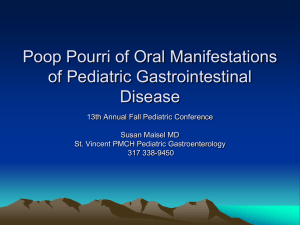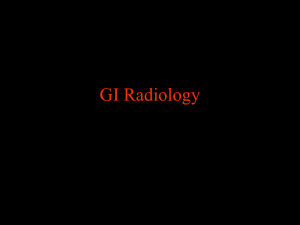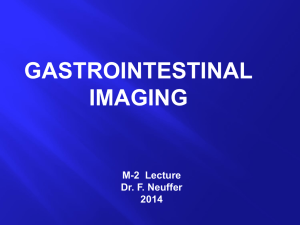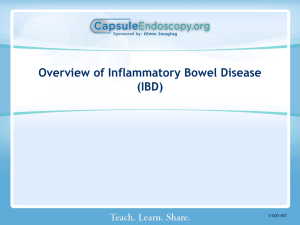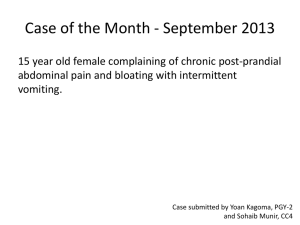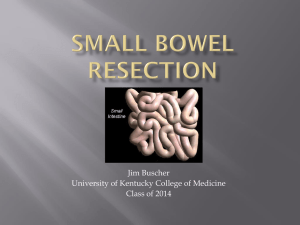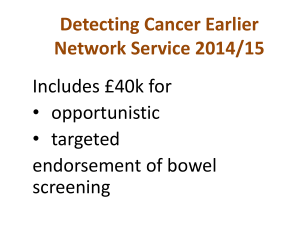Crohn Disease
advertisement
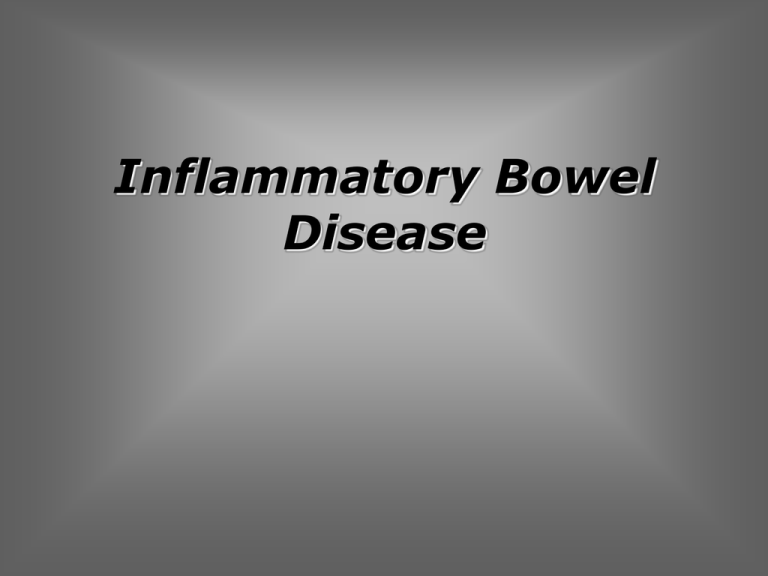
Inflammatory Bowel Disease Inflammatory Bowel Disease Inflammatory bowel disease (IBD) is an idiopathic disease, probably involving an immune reaction of the body to its own intestinal tract. The 2 major types of IBD are ulcerative colitis (UC) and Crohn disease (CD). Frequency: In the US: • Approximately 1 million people in the United States have UC or CD. • The prevalence of IBD among Americans of African descent is estimated to be the same as the prevalence among Americans of European descent. • The prevalence is lower among Americans of Asian and Hispanic descent. Internationally: • The incidence of IBD is assumed to be highest in developed countries and lowest in the developing regions of the world. Inflammatory Bowel Disease Crohn disease • CD consists of segmental involvement by a nonspecific granulomatous inflammatory process. • The most important pathologic feature is involvement of all layers of the bowel, not just the mucosa and the submucosa, as is characteristic of UC. • CD is discontinuous, with skip areas interspersed between one or more involved areas. • Late in the disease, the mucosa develops a cobblestone appearance, which results from deep longitudinal ulcerations interlaced with intervening normal mucosa. Inflammatory Bowel Disease Crohn disease The 3 major patterns of involvement in CD are: 1. disease in the ileum and cecum, occurring in 40% of patients 2. disease confined to the small intestine, occurring in 30% of patients 3. disease confined to the colon, occurring in 25% of patients. • Rectal sparing is a typical but not constant feature of CD. However, anorectal complications (eg, fistulas, abscesses) are common. • Much less commonly, CD involves the more proximal parts of the GI tract, including the mouth, tongue, esophagus, stomach, and duodenum. CD causes 3 patterns of involvement: 1. inflammatory disease, 2. strictures 3. fistulas. Inflammatory Bowel Disease Ulcerative colitis • Inflammation always begins in the rectum, extends proximally a certain distance, and then abruptly stops. • A clear demarcation exists between involved and uninvolved mucosa. • The rectum is always involved in UC, and no "skip areas" are present. • UC primarily involves the mucosa and the submucosa, with formation of crypt abscesses and mucosal ulceration. Inflammatory Bowel Disease Ulcerative colitis • UC remains confined to the rectum in approximately 25% of cases. In the remainder of cases, UC spreads proximally and contiguously. • Pancolitis occurs in 10% of patients. • The small intestine is never involved, except when the distal terminal ileum is inflamed in a superficial manner, referred to as backwash ileitis. • As the disease becomes chronic, the colon becomes a rigid foreshortened tube that lacks its usual haustral markings, leading to the lead pipe („stove-pipe”) appearance observed on barium enema. • The skip areas (ie, normal areas of the bowel interspersed with diseased areas) observed in CD of the colon do not occur in UC. Inflammatory Bowel Disease • UC and CD are generally diagnosed using clinical, endoscopic, and histologic criteria. • No single finding is absolutely diagnostic for one disease or the other. • Approximately 20% of patients have a clinical picture that falls between CD and UC; they are said to have indeterminate colitis. Distinguishing Features of CD Versus UC Features Crohn Disease Ulcerative Colitis Skip areas Common Never Cobblestone mucosa Common Rare Transmural involvement Common Occasional Rectal sparing Common Never Perianal involvement Common Never Fistulas Common Never Strictures Common Occasional Granulomas Common Occasional Inflammatory Bowel Disease Distinguishing Features of CD Versus UC CD UC Inflammatory Bowel Disease Imaging Studies - plain radiography The role of plain radiography is fairly limited. The 2 major purposes that it serves are: 1. to assess the presence of intestinal obstruction and 2. to evaluate pneumoperitoneum prior to further radiological workup. Inflammatory Bowel Disease Toxic megacolon is a complication of inflammatory bowel disease. It is due to transmural inflammation with loss of neuromuscular function. There is loss of the normal mucosal outline to the large bowel, with an irregular margin and no visible haustral markings, indicating mucosal inflammation and oedema. There is marked dilatation of the large bowel, from the caecum on the right to a loop of sigmoid seen centrally in the pelvis. The appearances and the extent indicate a pancolitis. The transverse colon measures more than 5.5 cm across, which in the presence of colitis indicates a toxic megacolon, with the risk of imminent perforation It constitutes a surgical emergency. Inflammatory Bowel Disease There is a high congruence (95%) between the radiological and endoscopic diagnosis. Although generally safe and well tolerated, DCBE (Double Contrast Barium Enema) is relatively contraindicated in patients with severe colitis as it may precipitate toxic megacolon or perforation. Inflammatory Bowel Disease Imaging Studies - DC barium enema Normal barium enema findings virtually exclude active ulcerative colitis, whereas abnormal findings can be diagnostic. Several terms have been used to describe abnormalities found after barium studies of the colon. These include: 1. a “stove-pipe” appearance, which suggests chronic colitis that has resulted in a loss of colonic haustrae; 2. “rectal sparing”, which suggests Crohn colitis in the presence of inflammatory changes in other portions of the colon; 3. “thumbprinting”, which indicates mucosal inflammation 4. “skip lesions” (discontinuous disease), which suggests areas of inflammation alternating with normal-appearing areas, again suggesting Crohn colitis Inflammatory Bowel Disease Imaging Studies - DC barium enema a “stove-pipe” appearance ulcerative colitis ulcerative colitis Giant barrel sponge (Xestospongia muta) Stove-pipe sponge (Aplysina archeri) Inflammatory Bowel Disease Imaging Studies - DC barium enema “rectal sparing” - Crohn colitis The film shows a narrowing of the descending colon, as well as an area of narrowing with speculation in the splenic flexure. Crohn colitis The areas of “skip lesions” are typical of a diagnosis of Crohn’s disease. Inflammatory Bowel Disease Imaging Studies - DC barium enema Bowel wall "thumbprinting" is a radiological sign of thickening of the colonic wall. It occurs secondary to submucosal haemorrhage and oedema from capillary leakage Intestinal “thumbprinting”of the transverse colon. This sign can also be seen frequently on the abdominal flat plate Inflammatory Bowel Disease Imaging Studies - DC barium enema Crohn colitis The irregular involvement in the colon, skip lesions, and the string sign – Crohn disease. Inflammatory Bowel Disease Imaging Studies - DC barium enema Crohn colitis aphthous ulcers „cobblestone” appearance fissures and string sign Inflammatory Bowel Disease Imaging Studies - DC barium enema ulcerative colitis normal mucosa superficial ulcerations extensive ulcerations granular mucosa inflammatory pseudopolyps Inflammatory Bowel Disease Barium Enema Findings In Inflammatory Bowel Disease Inflammatory Bowel Disease Small bowel series/small bowel follow-through The small bowel series, with or without an upper gastrointestinal tract series, provides invaluable information about Crohn disease. The small bowel series is usually sufficient for the evaluation of small intestine Crohn disease This study can reveal if inflammation is present, can assist in the assessment of stricture length and severity, and can help decide the most appropriate surgical approach. Fistulae are often demonstrated on films from a small bowel series, even if they are not suggested based on the clinical evaluation. Inflammatory Bowel Disease Small bowel series/small bowel follow-through Changes of early/intermediate Crohn's disease, with thickened folds, tending to asymmetry and obliteration in places. Inflammatory Bowel Disease Small bowel enteroclysis The enteroclysis differs from a small bowel series in that a nasoenteric or oroenteric tube is placed and contrast is instilled directly into the small intestine. This is usually performed when fine detail of the intestinal mucosa is required or the distal small intestine is not adequately seen on the small bowel series because the contrast is diluted as it passes through the (usually dilated) small bowel. Inflammatory Bowel Disease Small bowel enteroclysis Conventional posteroanterior enteroclysis image shows a long high-grade stricture of a jejunal loop (arrowheads) and a jejunocolic fistula (arrows) From: Radiology. 2000;215:717-725. Small-Bowel Disease: Comparison of MR Enteroclysis Images with Conventional Enteroclysis and Surgical Findings H. W. Umschaden et al. Inflammatory Bowel Disease CT SCAN • CT scanning of the abdomen and pelvis has limited use in the diagnosis of IBD, but findings may be very suggestive of IBD. • Wall thickening on CT scans is nonspecific and may occur from smooth muscle contraction alone, especially in the absence of other extraintestinal inflammatory changes; however, the presence of inflammatory changes significantly increases the predictive value of the CT scan. • CT scanning is the ideal study to determine if the patient has abscesses, and it can be used to guide percutaneous drainage of these abscesses. Inflammatory Bowel Disease CAT SCAN Typical appearances of active Crohn disease. Transverse CT images show segmental luminal narrowing, mural thickening (arrows), mucosal hyperenhancement (arrowhead), and low-grade partial small bowel obstruction. Small bowel follow-through image shows eccentric narrowing and string sign (arrows) in the same bowel loop. From: Radiology 2003;229:275-281. Assessment of Small Bowel Crohn Disease: Noninvasive Peroral CT Enterography Compared with Other Imaging Methods and Endoscopy Peter B. Wold, et al. Inflammatory Bowel Disease CAT SCAN CT enteroclysis Inflammatory Bowel Disease MRI Traditionally, MRI has had a well-defined role in evaluation of anorectal complications of Crohn disease. Recently, the development of faster pulse sequences (eg, single-shot fast spin-echo and gradient-echo sequences) and higher-gradient systems has made T1- and T2-weighted breath-hold imaging possible. This breath-hold imaging has been a major breakthrough in overcoming physiologic motion artifacts in abdominal imaging. It has made routine abdominal MRI feasible. Because of a decrease in cumulative radiation exposure and because of the possibility of attaining high-quality coronal images correlating with barium studies, MRI is currently being investigated for monitoring disease activity in Crohn disease. Inflammatory Bowel Disease MRI Active Crohn disease in the terminal ileum. Narrowing of the involved bowel segment with prestenotic dilatation is shown on conventional enteroclysis (a), postgadolinium three-dimensional FLASH (b), and true FISP (c) images. From: Radiographics. 2001;21:S161-S172. MR Enteroclysis Imaging of Crohn Disease Panos Prassopoulos, MD et al. Inflammatory Bowel Disease Ultrasound • US features are nonspecific and include bowel wall thickening, which may involve both the hypoechoic muscular coat and the echogenic mucosa. • There is longitudinally extending wall thickening, with decreased echogenicity and luminal narrowing. • Localized perforation may lead to the formation of an abscess, which may be clinically silent if the patient is receiving steroid therapy. Inflammatory Bowel Disease Capsule enteroscopy: This technique is performed by having the patient swallow an encapsulated video camera that transmits images to a receiver outside the patient. Most commonly used for finding obscure sources of gastrointestinal blood loss, the images can find ulcerations associated with Crohn disease if upper endoscopy and colonoscopy are unrevealing. The major risk in patients with Crohn disease is the potential for the camera to become lodged at the point of a stricture, which could require operative intervention for removal. Inflammatory Bowel Disease Inflammatory Bowel Disease A study published in the June issue of The American Journal of Gastroenterology (Volume 98, Issue 6) concludes that capsule endoscopy is better than enteroclysis in diagnosing small bowel ulcers. "The results of this study indicate that wireless capsule endoscopy is better than enteroclysis in the diagnosis of small bowel ulcers. Wireless capsule endoscopy is the new gold standard for detecting Crohn’s disease in the small bowel." said Douglas K. Rex, M.D., F.A.C.G., Professor of Medicine, Division of Gastroenterology and Hepatology, Department of Medicine, Indiana University School of Medicine, and President-elect of the American College of Gastroenterology (ACG). „CONCLUSION: In patients without a small-bowel stricture at barium study, more small-bowel disease was found at CE when findings were retrospectively compared with barium examination and CT findings.” Radiology 2004;230:260. Small Bowel: Preliminary Comparison of Capsule Endoscopy with Barium Study and CT Amy K. Hara et al. Inflammatory Bowel Disease The FDA’s decision, together with peer reviewed publications, confirm that Capsule Endoscopy should be the first line diagnostic tool to evaluate patients with persistent abdominal symptoms following a negative upper and lower endoscopy. Diverticular Disease Diverticular Disease Diverticular disease of the colon begins as diverticulosis (colonic outpouchings), which may develop into diverticulitis (diverticular inflammation and perforation). Diverticular Disease • Diverticular disease is the most common colon disease in Western nations. In the West, colonic diverticula occur in 5% of the population by the time individuals are aged 40 years. • They affect 33-50% of the population older than 50 years and more than 50% of the population older than 80 years. • Diverticulitis is the most common complication of diverticulosis, and it has been reported in 10-20% of patients with diverticulosis. • Approximately 20% of patients with diverticulitis require surgical treatment. • In underdeveloped nations in Asia and Africa, diverticulosis occurs in less than 0.2% of the population. This low rate is probably the result of a high-fiber diet. Diverticular Disease • Diverticula can be either acquired or congenital, and it can affect either the small intestine or the large intestine. • Acquired diverticula are more common and consist of herniation of the mucosa and submucosa through the muscularis, usually at the site of a nutrient artery. • Diverticula involve the sigmoid colon in as many as 95% of patients with diverticulosis. The cecum is involved in 5% of patients. Diverticular Disease Barium study The appearance of diverticula varies with the projection in which they are viewed and with the amount of air and barium they contain. • In profile, a diverticulum appears as a protrusion outside of the colon that is joined to the colonic wall by a neck. • En face, a diverticulum may appear as a well-defined collection of barium or as a ring shadow. It may resemble a bowler hat. Diverticular Disease Barium study The appearance of diverticula varies with the projection in which they are viewed and with the amount of air and barium they contain. • In profile, a diverticulum appears as a protrusion outside of the colon that is joined to the colonic wall by a neck. • En face, a diverticulum may appear as a welldefined collection of barium or as a ring shadow. It may resemble a bowler hat. Diverticulitis Barium study A single-contrast examination is the preferred method in patients in whom diverticulitis is suspected. Diverticulitis Barium study Many features of diverticulitis are depicted on barium enema images. Narrowing, deformity, or displacement of the bowel lumen is commonly seen. Diverticulitis On barium enema examination, diverticulitis can be diagnosed by recognizing a perforated diverticulum. Barium may track through a perforated diverticulum into a sinus tract, fistula, or abscess. Less commonly, it may extravasate freely into the peritoneum. Single-contrast barium enema study demonstrates sigmoid diverticulitis with a colovesical fistula. Note the contrast material in the bladder. Diverticulitis On barium enema examination, diverticulitis can be diagnosed by recognizing a perforated diverticulum. Barium may track through a perforated diverticulum into a sinus tract, fistula, or abscess. Less commonly, it may extravasate freely into the peritoneum. Single-contrast barium enema study in a patient with diverticulitis demonstrates an intramural abscess filling with barium. Diverticulitis The preferred examination is CT scanning of the abdomen and pelvis. CT findings can help in confirming clinical suspicion of diverticulitis and in excluding other abdominal or pelvic disease. Diverticulitis The most common CT finding is paracolic fat stranding. The fat stranding characteristically is disproportionately more severe than the relatively mild, focal colonic wall thickening. Diverticulitis. Axial CT image of a man with left-sided diverticulitis shows severe pericolonic fat stranding that is greater than the degree of wall thickening of the descending colon. A "normal" diverticulum (open arrow) and a ill-defined (fuzzy) diverticulum (solid straight arrow) are also seen. From: „Disproportionate Fat Stranding: A Helpful CT Sign in Patients with Acute Abdominal Pain” J. M. Pereira et al. RadioGraphics 2004;24:703-715 Diverticulitis The inflammatory process can result in accumulation of fluid in the root of the sigmoid mesentery, which appears on CT scans as the "comma sign", and engorgement of the mesenteric vessels, which appears as the "centipede sign". Diverticulitis and the comma sign. Axial nonenhanced CT image of a 47-year-old patient with cecal diverticulitis shows thickening of the lateral conal fascia, a finding known as the reverse comma sign (arrowhead). Note the mild wall thickening of the cecum (small arrow) and a diverticulum (large arrow). From: „Disproportionate Fat Stranding: A Helpful CT Sign in Patients with Acute Abdominal Pain” J. M. Pereira et al. RadioGraphics 2004;24:703-715 Diverticulitis The inflammatory process can result in accumulation of fluid in the root of the sigmoid mesentery, which appears on CT scans as the "comma sign", and engorgement of the mesenteric vessels, which appears as the "centipede sign" . Diverticulitis and the centipede sign. Axial contrast-enhanced CT image of a patient with diverticulitis shows engorgement of the vasa recta that feeds the sigmoid colon, a finding known as the centipede sign (open arrows). Note also the mild wall thickening of the colon (long solid arrow), diverticula (arrowheads), and fluid at the root of the sigmoid mesentery (short solid arrow). From: „Disproportionate Fat Stranding: A Helpful CT Sign in Patients with Acute Abdominal Pain” J. M. Pereira et al. RadioGraphics 2004;24:703-715 Diverticulitis The most important entity in the differential diagnosis to exclude is colon adenocarcinoma. Differentiating Features of Diverticulitis and Colon Adenocarcinoma on CT: From: „Disproportionate Fat Stranding: A Helpful CT Sign in Patients with Acute Abdominal Pain” J. M. Pereira et al. RadioGraphics 2004;24:703-715 Diverticulitis The most important entity in the differential diagnosis to exclude is colon adenocarcinoma. Colon adenocarcinoma. Axial contrast-enhanced CT image shows severe wall thickening of the ascending colon with no fat stranding. This disproportionate degree of thickening suggests that the patient’s disease originates in the bowel wall. The most common CT finding is paracolic fat stranding. From: „Disproportionate Fat Stranding: A Helpful CT Sign in Patients with Acute Abdominal Pain” J. M. Pereira et al. RadioGraphics 2004;24:703-715
